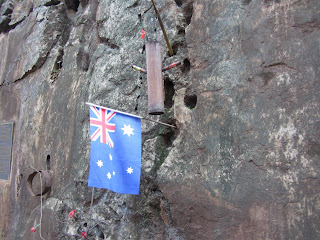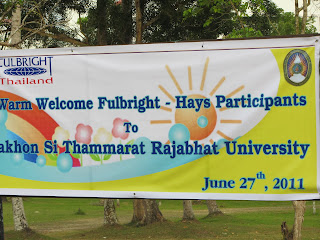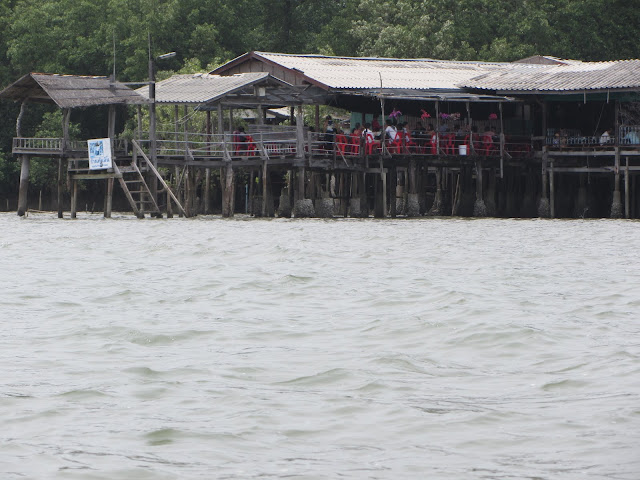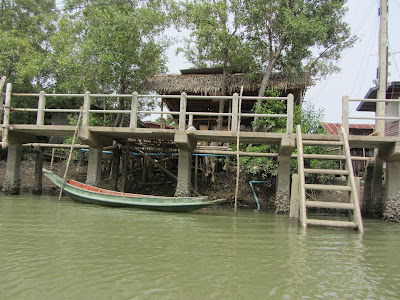 |
| One of our Thai hosts and her 15 year old friend who hopes to study in the U.S. |
Mai Pen Rai is an expression the Thais use often. Thai people don’t worry about being late, they remain calm when they’re stuck in Bangkok’s horrific traffic jams, they shrug their shoulders when things break down. Miss your plane? Mai pen rai! Bus breaks down in a remote village? Mai pen rai! It’s basically the equivalent of our “never mind” or Africa’s “Hankuna matada”… and I needed to invoke it during my Thai “home-stay”. We were supposed to be staying at the homes of members of the Bangkok Rotary club. I found out that Shannon, a teacher from South Dakota, and I would be staying at the home of Salakjiit Nopakun and her husband. A little nervous about staying in someone else’s home, we were also excited to find out more about typical Thai family life. But when Salakjiit picked us up we were forced to say, “Mai pen rai!” She is a warm, wonderful, and wealthy woman who, a) didn’t want to disturb her home routine with houseguests, and b) wanted to show us Thai hospitality by giving us a treat. So she and her two friends who were also hosting Fulbrighters had rented a huge van to take us to a seaside resort about two hours from Bangkok! It was quite interesting, but not the home-stay experience we’d been expecting!
Salakjiit’s nickname is “Jeet”. Thais almost always have nicknames because their real names are so long. The nicknames are rather interesting… “Jeet” means “Tiny”, one of her friends was nicknamed “Som”, which means the color orange, and other nicknames I’ve heard mean things like “Arm”, or “Grapefruit”. Jeet is an English language professor at a college and is the Immediate Past President of her Rotary Club. Her husband, Ed, is a international copyright lawyer (must get a lot of business in Thailand!) and is the President-Elect of the club.
The monkeys watched us feast on crab, mussels, and some weird wormy looking shellfish
They and their friends took us to a fishing village on the Bay of Siam for lunch at a quaint restaurant on a dock that specializes in shellfish. We ate the best of many delicious meals I’ve had in Thailand, feasting on crab, mussels, and some weird kind of shellfish I’d never seen before which is kind of stem-shaped and was delicious. The restaurant was overrun with monkeys who stayed away from our food but provided entertainment and great photo opportunities. Then Jeet rented two boats to take us back through the narrow canals of the fishing village. As you can see (if I’ve successfully posted the photos) the fishermen’s houses are all built up on stilts and are quite picturesque. Past the village we saw some great flora and fauna, including walking catfish and a giant Kimodo dragon (or was it a monitor lizard??) about 7 feet long. Of course, as soon as we got deep into the jungle our boat broke down!
Mai pen rai! Luckily it wasn’t too long before another boat came by and gave us a tow and eventually our boat driver was able to contact what must be the equivalent of AAA because a guy came in a small boat to repair our engine. It was a great adventure.
Our lunch restaurant from the Bay of Siam
Visiting a small Thai fishing village by boat
After lunch our hosts drove us to the beach where we checked into the ultra-luxurious Hilton Resort and Spa! It was a super-Hilton with water slides in the pool, lavish landscaping and impeccable service. After a swim in the Bay of Siam (giant jellyfish!) and the pool (fun waterslide!) we went to yet another seafood restaurant on the water where we drank coconut juice while we munched out on squid, sea bass, shrimp, and (I can’t believe I ate these in a foreign country) raw oysters. It was delicious and I’ve had absolutely no stomach repercussions from my feast. After dinner we went to an open market where we shopped for handicrafts and saw a cultural dance performance.
Typical market food
Thai silk dance
After a great night’s sleep in our luxurious hotel we breakfasted and headed out for the Royal Summer Palace. King Rama VI, who ruled during the early 20
th century, wanted a place to go enjoy the seaside so he constructed his summer palace at the beach. The palace is completely on stilts and 90% of it is open-air so he could enjoy the breeze coming off the Bay of Siam from all directions. We weren’t allowed to take photos inside the palace, but it was much more posh than it looks from the outside, with Chippendale furniture in the open-air banquet room, plumbing that would have been state-of-the-art in the 1920s, and even a theater! Rama VI had been educated in England and was a big fan of Shakespeare. He staged plays at his summer palace, his favorite being “Merchant of Venice” and Jeet told us he liked to take the women’s roles (which might explain why he left no immediate heirs and his nephew, Rama VII, had to take over when he died…
Mai pen rai!)
The king's summer palace
Rama VI's beach house!
The Bay of Siam from my hotel window
Rama VI was the grandson of Rama IV, the king from “The King and I”. Since Jeet is completely fluent in English and was educated in the U.S. at Ohio State I took the opportunity of asking her how the Thai people felt about the movie “The King and I”. Her answer: “It’s banned, but we’ve all seen it!” She said the Thai government has banned all three King and I films (Rex Harrison, Yul Brenner, and Jody Foster versions) but the Thai people can get them on the black market. She laughed it off, saying that since the Thai people knew it was fiction – that Rama IV had actually been a monk for 30 years before becoming king, that “Anna” really didn’t have a close relationship with him (she was just one of many tutors at the palace) and that he was an old, old man when she was in Thailand and certainly didn’t go around dancing and singing – that they just looked at the films as entertainment and didn’t take them seriously. I guess it’s kind of like how we just have to accept the fact that Disney fictionalized the Pocohontas story and instead of getting angry about we just disassociate ourselves from the fact that they’ve butchered history and enjoy the movie.

Our hosts treated us to some more shopping opportunities and meals and when we were finally returned to Bangkok we felt that the modest gifts we’d brought for them were unworthy in light of the great expense and time they’d spent on us. I gave them each a Stetson baseball T-shirt and Chipper Jones golf tournament hats (luckily Jeet’s husband does like to golf so perhaps he’ll appreciate the gift) – but it could no way repay the extraordinary hospitality we’d been shown. BTW, one of the Rotarians (Ome, whose husband is the governor of one of the Thai provinces) had her 15 year old daughter accompany us also and the girl, Nao, is interested in doing a Rotary exchange to America. We all assured her that we’d love to have her come and stay with us in the U.S., so maybe we will have the opportunity to adequately repay their kindness.




























































